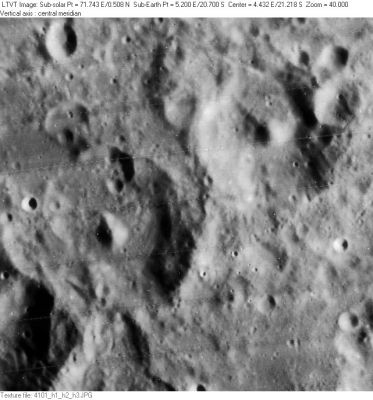Donati
Contents
[hide]Donati
|
Lat: 20.7°S, Long: 5.2°E, Diam: 36 km, Depth: 2.07 km, Rükl: 55 |
LO-IV-101H The two similar craters are Faye (left) and Donati (right). The shadowed region in the lower left is the eastern part of 46-km Delaunay.
Images
LPOD Photo Gallery Lunar Orbiter Images Apollo Images
- Although Donati is not mentioned in the LPI's search list for orbital Apollo photographs, it WAS captured on several frames made by Apollo 16's south-looking mapping/metric Fairchild camera, such as frame AS16-M-0707, in which Donati and Faye (and their central peaks) are noticeable near the central part of the curved horizon.
- Research: Danny Caes.
Maps
(LAC zone 95B3) LAC map Geologic map
Description
Description: Elger
(IAU Directions) DONATI.--A ring-plain on the S. of Airy C, about 22 miles in greatest length. It is very irregular in outline, with a lofty broken border, especially on the N. and S., where there are wide gaps. There is another ring on the S.W.
Description: Wikipedia
Additional Information
- Depth data from Kurt Fisher database
Westfall, 2000: 2.07 km
Cherrington, 1969: 2.74 km - From the shadows in LO-IV-101H, the central peak of Faye is 1400 m tall. There is a 1-km diameter crater at its summit. The central peak of Donati is about 1300 m tall. - JimMosher
- The central peak is 1.3 km tall Sekiguchi, 1972. - fatastronomer
Nomenclature
- Giovanni Battista Donati (December 16, 1826 – September 20, 1873) was an Italian astronomer. Between 1854 and 1864 he discovered six new comets, including the spectacular Comet Donati (C/1858 L1), found in 1858. He also pioneered spectroscopy of comets to determine their physical composition, discovering that the spectrum changed when a comet approached the Sun and heating caused it to emit its own light rather than reflected sunlight.
- According to Whitaker (p. 221), this name was introduced by Birt and Lee.
LPOD Articles
Bibliography
